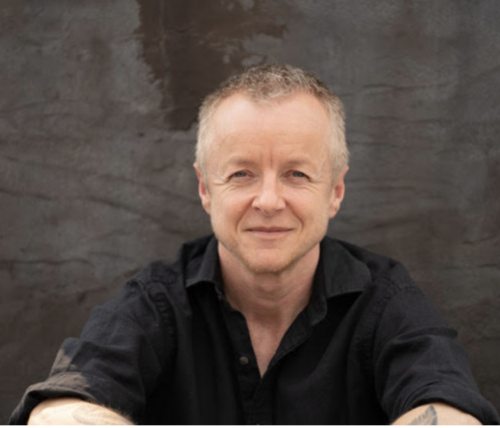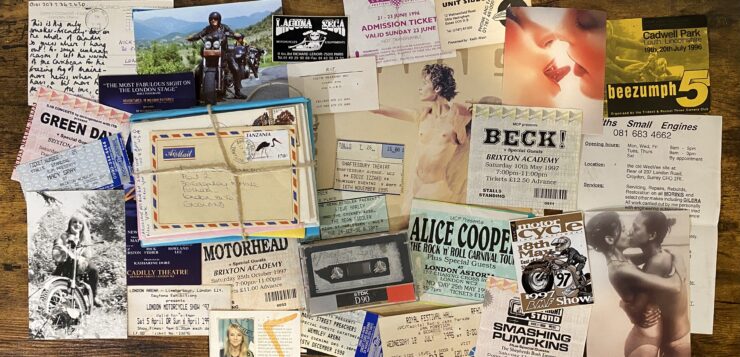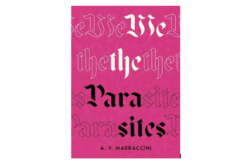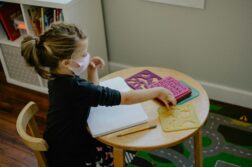
It was early on a Saturday morning, when I rose before dawn as usual to work on my memoir, and a search for a decades old photograph sent me into the darkest recess of my basement. I was looking for evidence of my tomboy phase, the period in the 1990s when I cut my hair short and only wore jeans, t-shirts, and motorcycle boots. There aren’t many photos left from that era since it was long before the digital age, but I hoped I might find a handful buried somewhere in one of the many shoeboxes in which I stored everything from the first four decades of my life.
I brought the boxes up to my living room and wiped off the cobwebs. Sorting through them was a trip. I forgot how much I kept: hundreds of photos spanning my various identities from the 1980s to the 2020s, from a young English girl at a single-sex boarding school to a motorcycle-riding tomboy in London, an affluent heterosexual housewife living in the English countryside, a divorced lesbian in Connecticut and, finally, my current incarnation as a trans man and father of four teenagers. Among the postcards and concert tickets from the early days were small signs of my closeted queerness: a thick wad of correspondence from a woman I’d been in love with, bundled together as if they were love-letters (they weren’t), a picture of two girls kissing I stole from a photographer I once worked for, a vinyl record with a half-naked androgynous model on the cover, and a handwritten list of famous gay men— the purpose of which I now can’t remember.
By late morning the contents of the boxes were spread out over the coffee table and across the sofa, and I was sitting on the only piece of floor which wasn’t covered in paper, feeling like a sleuth in a detective novel. This was how my teenage daughters found me when they woke up. As they wandered around the room in their pajamas, picking things up and asking questions, I fought the urge to grab my stuff out of their hands, shoo them out of the room, and shove everything back into the boxes. They’ll be able to see who I am, I thought, irrationally. They’ll put the pieces together and they’ll crack the case. The fear response was so deeply ingrained it took all of my strength to override it, even though I’d been out for decades and had no secrets from my children.
But even if I had still been closeted, I knew it would be almost impossible to form a cohesive narrative from the confusing evidence laid out in front of me. It had taken me over forty years to figure it out myself, and I was the main suspect. My obsession with certain women had spoken to my sexual orientation, but I hadn’t identified with the lesbians at art school, because I wasn’t a queer woman. My motorcycle had been a manifestation of my masculinity, but I wasn’t like the bikers I hung around with because I wasn’t a straight man. I was drawn to the androgyny of the model on the album cover, but this didn’t answer any of the questions I had about my own body. The effeminacy that was usually found in gay men came naturally to me, and yet I wasn’t that kind of gay.
It wasn’t until after I came out and discovered Leslie Feinberg and Judith Butler that my identity started to make sense to me, although even then I struggled to make the pieces fit. In order to justify transitioning, I believed I would first have to claim that my gender was male, but my gender had always felt more like an intricate, complex mix of masculine and feminine—not quite male enough to justify such a radical move. If I aligned my sex with my gender, I reasoned, that would surely make me nonbinary. So, for a while that’s what I tried to be. I adopted a masculine name, got top surgery and toyed with they/them pronouns. But while this presentation made sense in theory, in practice it did little to assuage my dysphoria.
Worse, the pendulum of my gender performance was now swinging uncomfortably in the opposite direction. I always knew that “acting like a girl” felt wrong, but in order to compensate for the parts of my body which were still female, I was now trying too hard to “act like a boy.” It seemed that performative masculinity felt just as inauthentic as performative femininity. I wanted to stop performing, and just be.
It was only after a year of obsessing about whether or not I should start testosterone that I began to wonder if the problem was my sex, not my gender. Perhaps it wasn’t my femininity that caused of my dysphoria, but the fact that my body still retained traces of the female sex. Irrespective of how nonbinary my gender felt, my body wanted to be fully male.
Looking at the clues on the coffee table, I could see that in the absence of seeing my complete reflection in someone else’s presentation, my subconscious had been searching for things that were in conversation with all these different parts of me that I didn’t understand. On some level I’d always known that the separate parts of my identity—my gender (how I felt/wanted to behave), my sex (how my body needed to be), and my sexual orientation (who I wanted to be with)—didn’t align with each other in the way I’d been told they should, whether I identified as cis or trans.
Judith Butler, of course, has always spoken to this complexity. In their latest book, Who’s Afraid of Gender, they say that “gender names the potential incommensurability of bodies with their categories.” But over time the word “gender” seems to have succumbed to the gravitational pull of the binary, and become a rigid identity that we are told we need to align our bodies to, instead of just being a useful tool for speaking about bodies that aren’t aligned with social expectations. It was only once I understood that my gender was fluid, my body was male, and my sexual orientation skewed towards women—and crucially, that none of these things needed to line up with any of the others—that everything finally started to make sense. If my body was male, regardless of my gender, then I wanted to transition.
When I tell people I haven’t changed since my transition, what I mean is that I haven’t lost any of my learned feminine qualities now that I’m a man. I still tilt my head when I’m listening, cross my legs when I sit, and soften my voice if one of my children is hurt or upset. Of course, this means that I mostly get read as a gay man, and while this has its advantages—women aren’t threatened by me and being hit on by other gay men is surprisingly validating—it can make dating a little complicated. Still, it’s a small price to pay for feeling whole.
Eventually I found the photograph I was looking for, put the rest of the keepsakes back in their boxes, and tucked them away back into the dusty corner of the basement. I couldn’t quite bring myself to throw the boxes out, but I also couldn’t imagine I’d be opening them again anytime soon. Now that I have a male body I no longer need mementos or tchotchkes to tell me who I am. I’ve finally managed to become more than just the sum of my parts.
 Oliver Radclyffe is the author of the monograph Adult Human Male, and the memoir Frighten the Horses, which was one of Oprah Daily and People Magazine’s best books of the fall. His work has been published in the New York Times, Electric Literature, and Them. He currently lives on the Connecticut coast where he is raising his four children.
Oliver Radclyffe is the author of the monograph Adult Human Male, and the memoir Frighten the Horses, which was one of Oprah Daily and People Magazine’s best books of the fall. His work has been published in the New York Times, Electric Literature, and Them. He currently lives on the Connecticut coast where he is raising his four children. 





